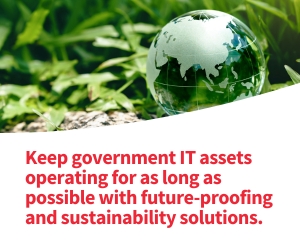Agencies Should Consider Tech’s Environmental Impact
At the same time, constituents are showing interest in circular economies to limit environmental impact. The public is increasingly aware of how e-waste — from mobile phones to servers and networking equipment — impacts the environment.
As these interests cross over into the workplace, constituents are also considered employees that show preference for sustainable workplaces. More than half of Generation Z and millennial workers research an organization’s environmental impact and policies before accepting a job. This means that attracting and retaining employees requires thoughtful sustainability practices.
The challenges are varied, but one way every government agency can reduce its own environmental impact is by implementing sustainable technology in its own operations — without sacrificing performance or increasing costs. This includes adopting devices that are manufactured with ecologically conscious processes, looking for technology that contains post-consumer recycled content and identifying tech services that strive to be carbon-neutral.
Today, many popular devices are manufactured with sustainability in mind. Lenovo, for instance, offers nearly 300 products containing post-consumer recycled content and has eliminated 10,000 tons of carbon dioxide emissions since 2017 via a manufacturing process called low-temperature soldering. Lenovo has also innovated to make data centers more energy efficient with liquid cooling technology, such as Lenovo Neptune, which delivers 98 percent heat-removal efficiency and up to 40 percent lower power consumption.
Beyond the physical devices, forward-thinking manufacturers are making select packaging from renewable materials such as bamboo and sugar cane and taking part in responsible sourcing practices — aiming to make devices in plants closer to the locations where they will ultimately be shipped and sold.
READ MORE: State and local governments strengthen services through data center optimization.
Trusted Partners Can Help Achieve Sustainability
While an agency’s physical technology can help improve its track record for sustainability, it can also reduce its environmental impact by leveraging managed services provided by a technology partner. Managed services from a trusted partner can help state or local governments reduce operational workloads, keeping devices on the job longer and reducing the need to purchase newer ones.
When evaluating technology partners, government agencies will want to consider those who offer the latest technology and comprehensive help desk support and those that hold multiple certifications from the U.S. government. This leads to more uptime and less device turnover and ultimately contributes toward the agency’s sustainability goals.
I’m proud of Lenovo’s leadership in sustainable technology practices and innovation. In 2023, Lenovo announced its commitment to reaching net-zero emissions by 2050, with targets validated by the Science Based Targets initiative’s Net-Zero Standard. One year later, Lenovo is on-track to meet its near-term emissions reduction goals. As a company, we are leading the way in a collaborative and accountable journey to net zero, and we are fully committed to helping our state and local government agency partners wherever they are on the path to sustainability.











